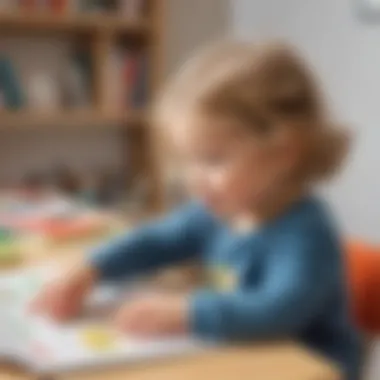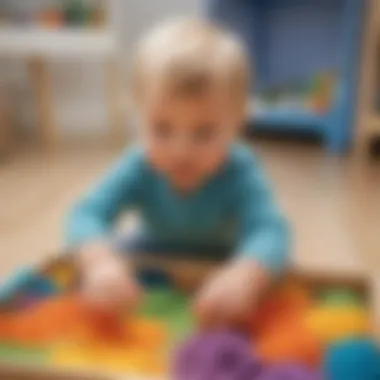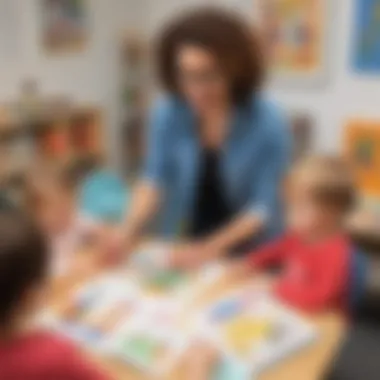Innovative Strategies for Teaching Two and Three-Year-Olds: A Tailored Approach


Creative Activities
Craft Ideas: Toddlers can engage in simple craft activities like finger painting, paper tearing, and clay modeling to enhance their creativity and fine motor skills. These activities provide an avenue for children to express themselves artistically while developing their hand-eye coordination.
Step-by-Step Guides: For each craft idea, detailed step-by-step instructions will be provided to guide parents and educators in facilitating the activity effectively. Clear directions on materials needed and the method of execution will ensure smooth implementation and joyful participation.
Educational Value: Engaging in these creative activities not only fosters artistic skills but also nurtures cognitive development. By exploring textures, colors, and shapes through hands-on crafting, children enhance their sensory perception and spatial awareness, laying a foundation for future learning endeavors.
Fun Quizzes
Quiz Topics: The quizzes available on Elem Fun cover a wide array of subjects tailored to stimulate young minds, including colors, animals, shapes, and basic numeracy. These diverse topics aim to captivate children's interest while expanding their knowledge base on fundamental concepts.
Question Types: The quizzes incorporate multiple-choice questions, picture-based inquiries, and interactive puzzles to create an engaging and interactive learning experience. By diversifying question types, children are encouraged to think critically, identify patterns, and make connections between information.
Knowledge Reinforcement: Through participation in fun quizzes, children not only consolidate existing knowledge but also develop problem-solving skills and memory retention. The quizzes serve as a playful tool to reinforce learning outcomes in a dynamic and enjoyable manner.
Fact-Based Articles
Topics: The fact-based articles encompass a wide range of captivating subjects, from exploring the wonders of nature to delving into historical milestones and scientific discoveries. Each article is meticulously crafted to pique children's curiosity and stimulate a thirst for knowledge.
Engaging Content: Presented in a digestible and engaging format, the articles utilize age-appropriate language and vivid illustrations to make complex topics accessible to young readers. By blending information with captivating storytelling, children are invited to embark on a fascinating educational journey.
Additional Resources: Alongside the articles, supplementary links to related resources and external sources are provided for further exploration. These resources offer avenues for extended learning and research, encouraging children to dive deeper into topics of interest and expand their understanding beyond the article content.
Understanding the Developmental Stage of Two and Three Year Olds
In this article, delving into the developmental stage of two and three-year-olds is crucial for educators and parents. Understanding the unique characteristics and needs of toddlers is central to tailoring effective teaching strategies. By focusing on cognitive, social, and emotional milestones, this section aims to provide comprehensive insights into early childhood development.
Cognitive Development Milestones
Language Acquisition
Exploring linguistic development in toddlers is fundamental for their overall growth. Language acquisition plays a pivotal role in communication and cognitive enhancement at this stage. Toddlers grasp new words rapidly, building their vocabulary and understanding of the world. This article sheds light on the significance of language acquisition in fostering expression and comprehension among two and three-year-olds.


Problem-Solving Skills
Problem-solving skills are vital for cognitive advancement in toddlers. Encouraging children to tackle challenges independently develops their critical thinking and decision-making abilities. This section emphasizes the importance of problem-solving activities in promoting logical reasoning and creative problem-solving approaches for toddlers' holistic development.
Social and Emotional Development
Building Relationships
Establishing strong social connections is key for toddlers' emotional well-being. Building relationships with peers and caregivers cultivates empathy and communication skills. This article discusses the benefits of nurturing relationships in fostering a sense of belonging and support in the social development of two and three-year-olds.
Self-Regulation
Self-regulation is a critical skill for emotional control and behavior management in toddlers. Learning to regulate emotions and impulses helps in social interactions and decision-making. This section highlights the significance of teaching self-regulation techniques to enhance toddlers' emotional intelligence and self-control abilities.
Creating an Enriching Learning Environment
In the realm of teaching two and three-year-olds, creating an enriching learning environment stands as a pivotal aspect. This is where the foundation of a child's developmental journey takes root, influenced by the surroundings they interact with daily. An enriching learning environment encompasses a blend of stimulating materials, engaging activities, and supportive interactions that cater to the unique learning styles of toddlers. It plays a fundamental role in fostering cognitive, social, and emotional growth during this crucial stage of early childhood.
Incorporating Play-Based Learning
Sensory Play Activities
A key component of play-based learning for toddlers is sensory play activities. These activities engage children through various senses like touch, sight, and sound, enabling them to explore and discover their surroundings in a hands-on manner. Sensory play aids in enhancing sensory processing skills, promoting cognitive development, and improving fine and gross motor skills. The tactile experience offered by sensory play activities is known to ignite curiosity and creativity in young minds, making it an essential choice for enriching the learning environment for two and three-year-olds.
Pretend Play Scenarios
Imaginative play, also known as pretend play scenarios, allows children to step into different roles and create imaginary worlds. This form of play-based learning fosters creativity, social skills, and language development in toddlers. Through pretend play, children learn to problem-solve, express emotions, and engage in peer interactions, laying the groundwork for empathy and cooperation. Pretend play scenarios provide a safe outlet for children to explore their emotions and navigate real-life situations, making it a valuable addition to the learning experiences of young children.
Utilizing Visual and Interactive Aids
Colorful Charts and Posters
Visual aids like colorful charts and posters are instrumental in reinforcing learning concepts and enhancing memory retention for toddlers. The vibrant visuals coupled with simple narratives help in simplifying complex ideas and making information more accessible to young learners. Colorful charts and posters add an element of fun and excitement to the learning environment, keeping children engaged and interested in the educational content presented. Their visual appeal and interactive nature make them a popular choice for creating an enriched learning space for two and three-year-olds.


Interactive Learning Apps
In the digital age, interactive learning apps have emerged as valuable tools for engaging young learners in educational activities. These apps provide interactive and engaging content that aligns with age-appropriate learning objectives. Through interactive learning apps, children can practice key skills, explore new concepts, and receive immediate feedback, enhancing their overall learning experience. The interactive nature of these apps stimulates curiosity and learning enthusiasm among toddlers, making them an effective addition to the toolkit for creating an enriching learning environment.
Effective Teaching Strategies for Toddlers
In the realm of teaching two and three-year-olds, effective strategies play a pivotal role in shaping the learning journey of these young minds. Understanding the cognitive and emotional development of toddlers is crucial for tailoring teaching approaches that resonate with their stage of growth. By incorporating innovative teaching methods specifically design for toddlers, educators and parents can significantly enhance the educational experience at this crucial age of early development.
Encouraging Hands-On Exploration
Sensory Bins
Delving into the realm of sensory bins represents a cornerstone in the pedagogical approach towards toddlers. Sensory bins entail containers filled with various materials like sand, water, rice, or beans, providing tactile stimuli for children's exploration. Their significance lies in nurturing sensory experiences, aiding in cognitive development and fine motor skills. The allure of sensory bins lies in their versatility, offering a multisensory learning experience that fosters creativity and imagination in toddlers. However, challenges can arise concerning messiness and supervision requirements, though the benefits of sensory bins outweigh these limitations.
Sorting and Matching Activities
Introducing toddlers to sorting and matching activities is instrumental in honing their cognitive abilities and critical thinking skills. These activities involve categorizing objects based on specific attributes or finding similarities among items, stimulating logical reasoning in young minds. The key characteristic of sorting and matching activities lies in their capacity to promote problem-solving skills and enhance visual discrimination. Such activities are popular for fostering cognitive development and encouraging cognitive flexibility, contributing significantly to the overall educational goals for toddlers. While these activities are beneficial, caregivers may encounter challenges in maintaining toddlers' engagement and interest, requiring creative approaches to sustain participation.
Implementing Routine and Structure
Visual Schedules
Integrating visual schedules into the daily routine of toddlers serves as a fundamental tool for promoting organization and predictability. Visual schedules consist of visual prompts or images representing different activities or tasks throughout the day, aiding toddlers in understanding and transitioning between various events. The inherent advantage of visual schedules lies in providing a visual aid for children, especially those with learning difficulties, to comprehend and anticipate daily routines effectively. While visual schedules create a structured environment conducive to learning and stability, caregivers should be mindful of adapting schedules to meet individual needs and preferences.
Transitional Cues
Embracing transitional cues as part of the educational approach for toddlers is paramount in fostering smooth transitions and minimizing disruptions. Transitional cues encompass signals or cues that indicate upcoming changes or transitions in activities, assisting toddlers in preparing mentally for the shift. The essence of transitional cues lies in promoting independence and self-regulation in toddlers, empowering them to navigate transitions with confidence. By utilizing transitional cues, caregivers can mitigate resistance to change and create a harmonious learning environment that facilitates seamless transitions. Despite the clear benefits of transitional cues, challenges may arise in establishing consistent cues and effectively communicating these cues to toddlers, necessitating patience and persistence in implementation.
Promoting Language and Communication Skills
In the realm of teaching two and three-year-olds, the development of language and communication skills holds paramount importance. By honing these crucial abilities, children can effectively express themselves, interact with others, and comprehend their surroundings. Encouraging language and communication skills fosters cognitive growth and sets a strong foundation for future academic success. Furthermore, enhancing these skills during early childhood can significantly influence a child's overall development.
Engaging Storytelling Sessions


Interactive Storybooks
Interactive storybooks are a valuable tool in promoting language and communication skills among toddlers. These engaging books not only captivate young minds but also facilitate interactive learning experiences. The immersive nature of interactive storybooks allows children to participate actively in the narrative, enhancing their comprehension and vocabulary. The integration of visuals, sounds, and interactive elements in these books stimulates multisensory engagement, making learning more dynamic and effective. Through interactive storybooks, children can develop a love for reading while honing crucial language skills.
Role-Playing Narratives
Role-playing narratives represent another compelling method to promote language and communication skills in two and three-year-olds. By engaging in role-playing activities, children enhance their verbal communication, imagination, and social interactions. Role-playing encourages language development as children adopt different roles, portray characters, and engage in storytelling. This hands-on approach to language learning allows toddlers to express themselves creatively, build confidence in communication, and explore various scenarios. Role-playing narratives help children broaden their vocabulary, improve articulation, and develop essential communication skills essential for effective verbal expression.
Encouraging Verbal Expression
Vocabulary Building Games
Integrating vocabulary building games into the learning curriculum of toddlers offers a dynamic approach to enhancing language and communication skills. These games not only make learning enjoyable but also expand the child's lexicon, improving their communication abilities. Vocabulary building games encourage children to explore new words, understand meanings in context, and practice articulating them. Through engaging activities and challenges, toddlers can enrich their vocabulary, grasp nuances in language, and boost their verbal fluency. Incorporating vocabulary building games in teaching strategies empowers children to communicate effectively, express ideas confidently, and engage in meaningful conversations.
Sing-Along Sessions
Sing-along sessions serve as a fun and engaging method to promote verbal expression and language development in two and three-year-olds. Music has a profound impact on language acquisition, memory retention, and emotional expression. Singing along to songs enhances a child's pronunciation, rhythm, and intonation, improving their speech skills. Moreover, the repetitive nature of songs aids in reinforcing vocabulary, promoting language retention, and fostering auditory processing. Sing-along sessions not only energize learning environments but also cultivate a deep appreciation for music, language, and self-expression. By integrating music into teaching approaches, educators can effectively nurture language skills, creativity, and verbal fluency in young learners.
Fostering Creativity and Imagination
In the realm of early childhood education, fostering creativity and imagination holds a paramount position. Encouraging artistic expression and imaginative play paves the way for holistic development in toddlers, transcending mere cognitive advancement to include emotional and social growth. Engaging in creative activities nurtures problem-solving skills, divergent thinking, and self-expression, fostering a sense of freedom and exploration in children at a tender age – a crucial foundation for lifelong learning. Additionally, fostering creativity and imagination aids in the enhancement of fine motor skills, hand-eye coordination, and overall cognitive development in two and three-year-olds. By immersing youngsters in creative pursuits, educators and parents cultivate a fertile ground for innovative thinking and self-discovery which are indispensable in the formative years.
Artistic Expression Activities
Finger Painting
Delving into the realm of finger painting in early childhood education unveils a myriad of benefits and enriching experiences for toddlers. Finger painting not only stimulates sensory exploration but also enhances hand-eye coordination and fine motor skills in young children. The tactile nature of finger painting allows little ones to experiment with colors, textures, and shapes, fostering their creativity and imagination in a hands-on manner. This artistic activity enables toddlers to engage with their senses, facilitating the expression of emotions and ideas through a non-verbal medium. Finger painting, a prevalent choice in early childhood settings, promotes self-expression and cognitive development, laying a strong foundation for artistic inclinations and creative thinking in the early years.
Collage Making
When it comes to artistic activities, collage making stands out as a versatile and engaging option for two and three-year-olds in educational environments. Collage making encourages children to explore various materials, textures, and colors, promoting tactile and visual sensory experiences. This activity cultivates fine motor skills as children manipulate and arrange different elements to create a cohesive piece of art. Collage making fosters creativity, imagination, and critical thinking in toddlers as they make decisions about composition and arrangement. Furthermore, this activity offers opportunities for self-expression and storytelling, allowing children to communicate their thoughts and feelings visually – a vital aspect of holistic development in early childhood education.
Exploring Nature and Outdoor Play
Engaging toddlers in exploring nature and outdoor play holds immense value in their developmental journey. Nature walks provide opportunities for youngsters to connect with the natural world, stimulating their curiosity, senses, and cognitive abilities. Through nature walks, children observe and investigate the environment, fostering an appreciation for biodiversity, textures, and patterns in nature. This outdoor activity promotes physical exercise, sensory stimulation, and enhances observational skills in two and three-year-olds. Furthermore, nature walks encourage emotional well-being by offering a sense of tranquility and connection to the natural elements, contributing to overall mental health and resilience in toddlers.
Gardening Activities
Introducing gardening activities to toddlers not only cultivates a love for nature but also instills valuable life skills and lessons at an early age. Gardening engages children in sensory experiences as they interact with soil, plants, and natural elements, fostering an understanding of growth cycles and sustainability. Gardening promotes fine motor skills, hand strength, and coordination as children engage in planting, watering, and nurturing plants. Moreover, this hands-on activity encourages responsibility, patience, and teamwork in young learners, fostering a sense of accomplishment and connection to the natural world. Gardening activities offer a multidimensional learning experience, integrating science, environmental stewardship, and creativity into the educational journey of two and three-year-olds.







